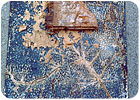
The Responsible Solutions to Mold Coalition (RSMC) was launched at the International Builders’ Show in January of 2006. The primary purpose of the group was to communicate science-based information on how to control moisture and therefore mold in buildings.
Comprising building materials associations, academic and government organizations as well as building materials companies, RSMC concluded that the vast amount of information on mold was difficult to navigate and sometimes misleading. Therefore, the group took on the mission of sifting through existing information in order to provide contractors, builders, architects and homeowners with the essential information they need in order to keep their buildings largely mold-free.

Careful planning and collaboration are required between architects, builders, contractors and owners to put into place systems that will prevent moisture intrusion that fosters mold growth.
A VERY SIMPLE PREMISE
As the group embarked on that mission, several issues became clear. Much of the information on moisture and mold control is highly technical and while important, might not be as helpful as some very basic advice. While this scientific discovery and debate is essential in arriving at accurate information, there are some basic things that if everyone involved in the construction industry observed, would eliminate most mold problems. This process starts with a very simple premise: If you keep buildings dry, you’ll eliminate mold.While there have been great advances made in the development of mold-resistant building materials-and they play an important role in today’s construction and remodeling markets-they are no substitute for good design, good building practices and good maintenance.
To that end, the group embarked on developing the Guiding Principles of Mold and Moisture Control. These take the form of approximately 50 recommendations divided by parts of the house that, if followed during and after construction, will eliminate most moisture and mold problems. RSMC is making this information available in a highly interactive format on its Web site, www.responsiblemoldsolutions.org. It also plans to distribute this information through media briefings with the consumer and trade press and hopes to extend the reach of this information to everyone with an interest in this topic.
Let’s start by discussing the jobsite. First and foremost, building materials need to be kept dry. This can mean proper storage once materials arrive on the jobsite, it can also mean careful scheduling of material delivery so they don’t arrive weeks before they’re needed. Materials need to be kept off the ground and covered. In the case of gypsum wallboard, it should not arrive on the jobsite until the building is largely closed in and therefore can be protected from the elements.
Not only do you need to schedule the arrival of building materials, you need to carefully schedule the various trades so that gaps don’t arise when enclosing the building envelope because of poor scheduling. For example, roofers need to be coordinated with the cladding contractors so that the proper flashing occurs where the two planes meet.
Design and Mechanical Issues
Let’s talk about some basic design and mechanical issues. Roofs need to be designed in a manner that water has a clear path downward towards the gutters and downspouts and away from the building. Sometimes you see some new roof designs that drain into valleys, which are not conducive to moving water away from a structure. Complicated roof designs that have multiple intersecting planes and valleys will concentrate water runoff from a large roof area into small, confined areas.Designers and contractors must recognize that such complexity brings with it increasingly stringent demands for closer attention to details such as valley flashings, drainage membranes and gutter configurations that ensure all of this water will be channeled safely off the roof and away from the building. Likewise, there is less margin for error or laxity in roof and gutter maintenance once the building is complete. It’s also not a good idea to place pipes, supply or waste, in exterior walls.
Baths and Kitchens
It’s important to use water resistive barriers behind all shower and tub installations. The simple fact is that water is absorbed into tile grout. When it weeps through, it needs to meet a barrier that prevents it from draining into the structure. An important detail requiring attention is to look at the drainage path at the bottom of the barrier to make sure the water will drain safely out of the wall rather than into the cavity. Bathroom and kitchen ventilation fans need to vent to the outdoors. Vents that empty into the attic or soffits can cause a moisture build-up that can freeze during the winter and turn into a wet attic floor and room ceiling come spring.Interior Construction
Wallboard should only be installed when the building is closed in. Wallboard should be hung off the floor so that if water comes in contact with it as a result of minor spills, it doesn’t wick up into the board. The resulting space should be sealed in order to retain air-tightness of the wallboard. During construction, to the extent possible, buildings should be kept open so that air can move through the structure allowing for the natural drying of joint compound, tile grout and eventually paint. If operational, central heat-but not air conditioning-should be kept on during the construction process in order to promote drying and avoid drastic temperature swings that can lead to condensation. Floor coverings should not be installed over poured slab concrete until the floor has dried sufficiently.A useful source of information on mold and moisture control has been produced by the Gypsum Association. The document entitled “Guidelines for Prevention of Mold Growth on Gypsum Board” can be found atwww.gypsum.org/pdf/GA-238-03.pdf.
Exterior Construction
Weather resistive barriers should be installed on the exterior of all buildings to protect against the intrusion of moisture. These barriers perform like a shell for buildings-liquid water that has penetrated the exterior does not pass through into the building, yet water vapor can escape. All windows and doors must have flashings installed. Flashings collect water from window and door leaks and safely direct the water away from the wall assembly. Roof flashing is imperative for all roofs. And it is important to include metal drip edges, valley flashings and flashing at the intersection of the roofs and vertical walls or chimneys. Exterior cladding should never touch the soil. If it comes in contact with the ground, it can transmit moisture into the building.Walls must be provided with a means to drain or the wall cavities will retain water that may lead to structural deterioration or mold. Inserting painters’ wedges between the siding boards will allow the wall to drain and therefore dry. Improper roof nailing causes roofs to leak. Avoid nailing shingles too high, using too few nails or failing to drive nails flush with the shingle surface.
Foundations
The grade around a building should slope away from it in order to facilitate drainage. The first 10 feet of soil extending outward from the house should be pitched away from the house at a 5 percent grade, or 6 inches of fall in the first 10 feet. The slope should be checked every few years to make sure that the backfill has not settled. It’s important to note that gravel or other ground cover tends to retain water. The slope must be established beneath the landscaping materials.Near-foundation irrigation can cause interior moisture or mold. The daily presence of water near the foundation increases the chances that some of the water will enter the building through absorbent cracks in the foundation. Any broken spray heads can place massive amounts of unwanted water near the foundation. If near-foundation irrigation is anticipated, it is even more important that the grade around the building slope away from it.
Vertical foundation walls, particularly for basements that may be occupied, should be protected and conditioned on the outside with a vapor barrier or liquefied membrane. Install perimeter drains both inside and outside the vertical foundation walls during new construction. By ringing the foundation both inside and out with perimeter drains, water should be taken away from the base of the foundation, thereby keeping the foundation and interior spaces of the house dry.
Maintenance
Once the contractor has left the jobsite, moisture avoidance becomes the responsibility of the home or building owner. While not complicated, this takes vigilance and discipline. Building owners need to check windows, doors and other wall penetrations once a year to ensure that caulking and glazing sealants are in place. In older brick homes, special attention needs to be paid to deteriorating mortar in exterior walls. All mortar can be penetrated by water, therefore special attention needs to be paid to brick pointing to prevent moisture intrusion.For the homeowner, replacing washing machine hoses every five years is a must. The largest category of insurance claims for water damage is failed washing machine hoses. It’s also important to replace water lines to refrigerator icemakers. These leaks are particularly problematic because water can seep out of small breaches in the line, which can foster mold growth in areas out of view. Also, placing washing machines, dishwashers and even refrigerators within pans that drain to the outside can go a long way toward eliminating potential water disasters. Water heaters should be replaced every 10-12 years.
During winter months with windows closed, there can be a build-up of moisture caused by unvented showers or stoves. Excessively long showers can also cause this build-up, which can be remedied by installing timers on all switches for vents. Running these fans for ten minutes after showering or cooking can eliminate a great deal of moisture build-up, as can simply lowering your humidifier. If you see condensation on the inside of windows, you know there is too much moisture being released in the building.
Remediation
The New York City Department of Health and Mental Hygiene continues to be an excellent source of information on remediation (http://www.nyc.gov/html/doh/html/epi/moldrpt1.shtml ). The rule of thumb is that any mold outbreak larger than 30 square feet should be left to the experts. Anything smaller than that can likely be handled by the building owner using warm, soapy water. It’s important to wear rubber gloves and a respirator while conducting the clean-up. Also, when finished, gloves, brushes, sponges and cloths should be discarded in a sealed plastic bag. The key to keeping mold at bay, however, is to find out where the moisture is coming from and take steps to stop it.Conclusion
Anyone doing an Internet search will find more than 20 million hits on the topic of mold. While no one can guarantee a building will remain mold-free, the simple steps outlined in the Guiding Principles of Mold and Moisture Control will go a long way toward keeping buildings safe, healthy and dry. We encourage everyone to visit our Web site to review these principles in greater detail (www.responsiblemoldsolutions.org). They can also be downloaded in poster format so that they can be posted at every jobsite.SIDEBAR: Groups, Companies United to Fight Mold
Members of Responsible Solutions to Mold Coalition (RSMC) include:• American Gypsum
• The Association of Wall and Ceiling Industries-International
• Building Research Council, School of Architecture, University of Illinois
• The Drywall Information Trust Fund
• The International Institute for Lath and Plaster
• The Lath and Plaster Institute of Northern California
• The Manufactured Housing Institute
• National Gypsum Co.
• National Institute of Building Sciences
• Network for the Advancement of Building Science, Syracuse University
• North American Insulation Manufacturers Association
• Northwest Wall & Ceiling Bureau
• Tile Council of North America
• USG Corp.
• Western Wall & Ceiling Contractors Association
• The U.S. Forest Products Laboratory.

Report Abusive Comment